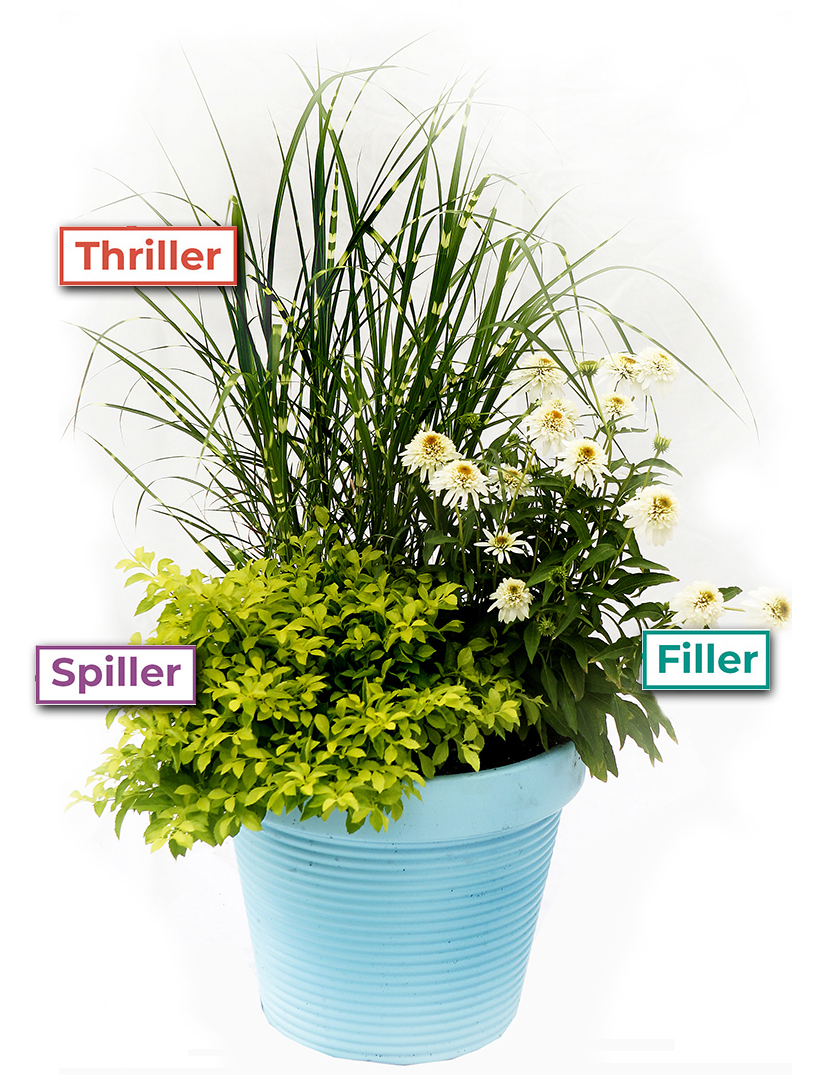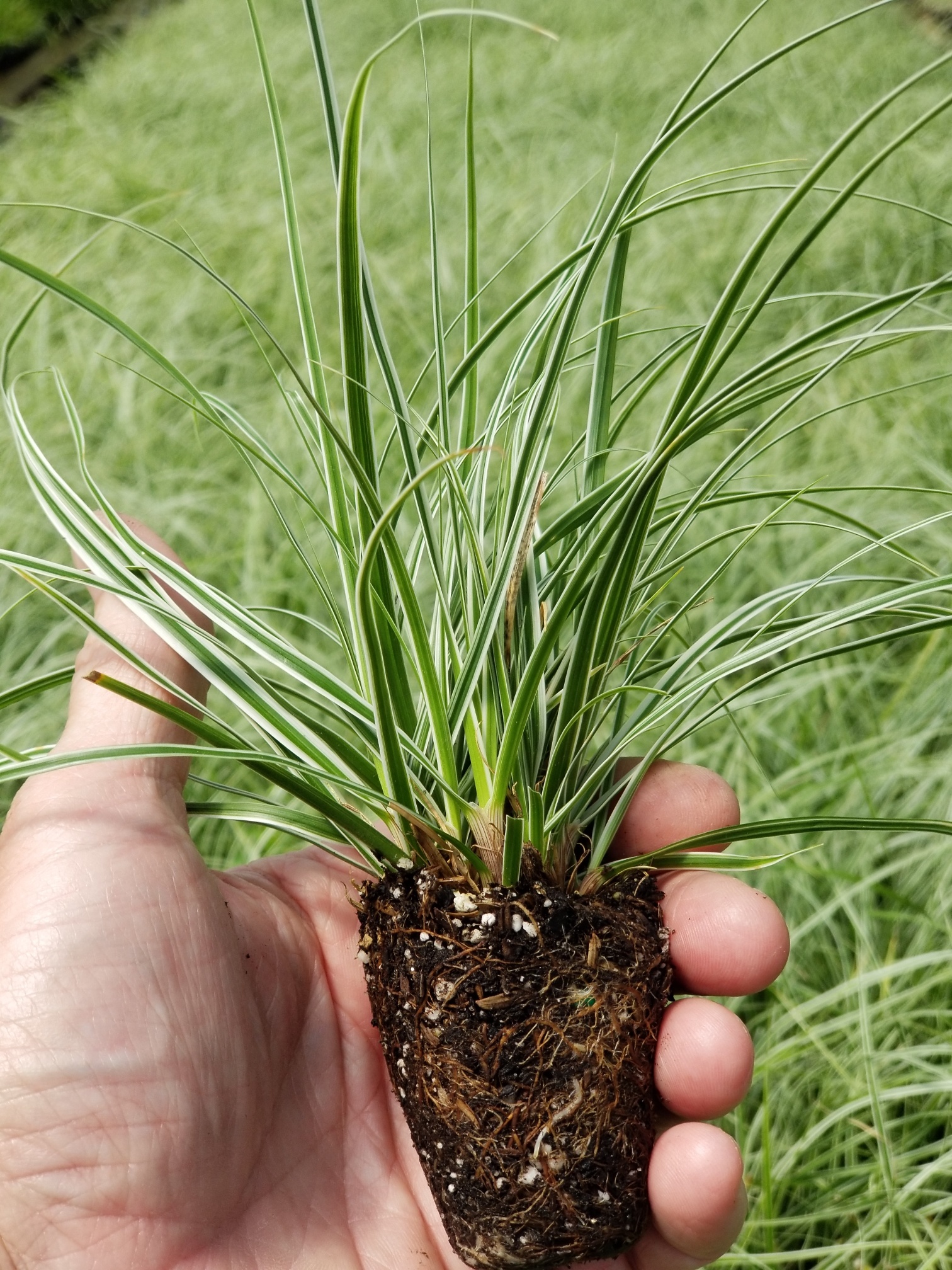Growing Perennials and Shrubs in Containers
Container perennial plantings have become popular in recent years for several reasons. There are many more decorative choices than ever before, in all materials and styles and shapes and sizes. Containers lend themselves to, and are an integral part of, another recent trend--exterior decorating of living spaces. Many live in condominiums, or have only small spaces for gardens, which containers lend themselves to readily. Containers can be purchased already planted, hence an instant landscape or gratification. Containers can also be changed out often during the season as plants come and go in bloom, particularly perennials, to create continuous bloom and a changing landscape.
If herbaceous perennials are grown in containers, keep in mind that in containers their roots are much more exposed and susceptible to winter injury than if they were in the soil. So unless in warm climates, or very hardy plants, perennials usually must be brought indoors over-wintered or else treated as annuals.
If over-wintering indoors, most perennials must be kept quite cool, preferably around 50 degrees but even 40 degrees to freezing may be best for many. Many alpines need cool temperatures, yet may be killed near freezing. Many perennials hardy to warmers zones such as 7 to 9 (0 degrees F and above in winter) should be kept at 50 degrees or above, or may be injured. During winter, some perennials may continue to grow or bloom slowly, others may go dormant, and many may need the cool temperatures in order to bloom well the following year. Grown in warmer conditions, as in homes, they may get too tall and spindly from too little light at the warmer temperatures, and may not bloom the following year.
The containers and potting mix
Most anything that holds soil may be used for containers from the traditional clay pots, to the many types of plastics now available, to old recycled items like boots or watering cans with holes or crack, to antiques such as advertising canisters or old farm containers. Points to keep in mind with any are:
- Make sure there is proper drainage; or if a pot is set inside another pot without drainage, empty the outer one frequently so water doesn't build up inside.
- Use a soil-less medium, or combine this with some well-rotted compost or composted manure. This will create the best root conditions, avoiding diseases and poor soil structure that garden soil often adds when used in pots. These media are also lighter than garden soils, which is especially important for moving large and heavy pots.
- Larger pots are more ideal for many perennials which can get quite large, but are more difficult to move and handle (unless on rollers). Smaller pots are more restrictive of roots, and dry out quickly which may often lead to plant damage.
- Clay pots are heavier than other material, and dry out most quickly. This can be useful for perennials which like drier soils, but a problem for others. Clay absorbs water, freezes and cracks in winter, so should be protected from the elements. They look more "natural", but many plastic pots now look very similar to clay and may be difficult to tell apart. Plastic pots of course dry out more slowly, and are lighter in weight. Metal pots may be light or heavy, depending on the pot, but often heat the soil more in sun and may lead to root damage.
- Wood containers can be used, especially if making your own. Use either a rot resistant wood such as cedar or cypress (avoid redwood for conservation reasons), or pressure treated exterior grade such as plywood. Be careful using wood sealers on the inside surfaces, as many contain chemicals toxic to roots.
- Homemade, or square containers, may be lined with styro-foam in order to moderate soil temperatures in hot climates, and winter temperatures if left outside in mild climates.
Growing Ornamental Grasses in Containers
As grasses become garden staples, they are also finding their way into more and more containers. Growing ornamental grasses in containers is a great way to feature grasses without the worry of them spreading or taking over the garden. Container grown ornamental grasses are also much easier to divide.
Be aware that when growing grasses in containers, their hardiness is raised by about 2 zones. An ornamental grass hardy to Zone 5, when planted in the ground, will probably only survive to Zone 7 in a pot. The actual hardiness of ornamental grasses grown in containers depends upon the location and material of the container and the extremely variable weather fluctuations of the winter months. However, you can always grow container ornamental grasses as annuals.
Thrillers, Fillers & Spillers
What is a thriller, filler, spiller? This set of simple rhyming words – thrillers, fillers, and spillers – removes the intimidation factor from container gardening design.
Thriller plants – Thrillers are the big, bold focal point of your container plant designs. This plant provides an eye-catching vertical element. Tall ornamental grasses such as purple fountain grass or Japanese sweet flag work well, but you can also use spiky blooming plants such as: Canna lily Asters Cosmos Salvia Dahlia If you’ll be viewing your container from all sides, the thriller goes in the middle. If your view the container from the front, plant the thriller in the back.
Filler plants – Fillers are mid-size, mounding, or rounded plants that surround and enhance the thriller and fill the space in the planter. You can use one filler or opt for two or three different plants in your container gardening design.
Spiller plants – Spillers are splashy plants that cascade and tumble over the sides of the container. Have some fun with your container gardening design!
Using thrillers, fillers, and spillers removes the complication from container flower gardening, allowing you to have fun and exercise your creative muscle. Just be sure to choose plants with the same sunlight and water requirements when selecting plants for your container plant designs.


